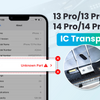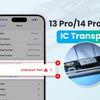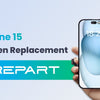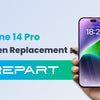iPhone Screen Replacement Cost in 2025: Apple vs. Third-Party vs. DIY

A cracked iPhone screen is a common and frustrating problem that can affect both functionality and the device's premium appearance. Whether the damage is a small crack or a completely shattered display, knowing the cost of iPhone screen replacement is essential for making an informed repair decision. This guide covers the costs, processes, and factors to consider when replacing an iPhone screen through Apple's official services, third-party repair shops, or DIY kits. Our aim is to help you evaluate the pros and cons of each option and choose the best solution for your needs.
Factors Influencing iPhone Screen Replacement Costs
Several factors influence the cost of repairing an iPhone screen:
- iPhone Model: Newer models with advanced displays, such as OLED screens in iPhone 16 and later, are more expensive to repair compared to older models with LCD screens, like the iPhone 8.
- Warranty or AppleCare+ Status: AppleCare+ significantly reduces repair costs, often to $29 per incident for screen damage. Without it, out-of-warranty repairs are more expensive.
- Repair Provider: Apple's official services use genuine parts but are more costly. Third-party shops may offer lower prices, though quality can vary. DIY repairs are the cheapest but carry more risk.
- Damage Severity: Minor cracks may only require glass replacement, while severe damage might necessitate a full display assembly replacement, increasing costs.
- Location: Repair costs can vary by region due to differences in labor rates and part availability.
Understanding these factors helps you estimate expenses and choose the most suitable repair option.
iPhone Screen Replacement Costs by Model
The cost of replacing an iPhone screen varies significantly depending on the model. Below is an overview of estimated replacement costs for popular iPhone models in 2025, based on Apple's official pricing and average third-party rates.
| iPhone Model | Apple (With AppleCare+) | Apple (Out-of-Warranty) | Third-Party (Average) | DIY Kit (Average) |
|---|---|---|---|---|
| iPhone 16 Pro Max | $29 | $379 | $180–$320 | $90–$160 |
| iPhone 16 Pro | $29 | $329 | $160–$280 | $80–$140 |
| iPhone 16 Plus | $29 | $329 | $160–$280 | $80–$140 |
| iPhone 16 | $29 | $279 | $140–$240 | $70–$120 |
| iPhone 16e | $29 | $229 | $120–$200 | $60–$100 |
| iPhone 15 Pro Max | $29 | $379 | $180–$320 | $90–$160 |
| iPhone 15 Pro | $29 | $329 | $160–$280 | $80–$140 |
| iPhone 15 Plus | $29 | $329 | $160–$280 | $80–$140 |
| iPhone 15 | $29 | $279 | $140–$240 | $70–$120 |
| iPhone 14 Pro Max | $29 | $379 | $180–$320 | $90–$160 |
| iPhone 14 Pro | $29 | $329 | $160–$280 | $80–$140 |
| iPhone 14 | $29 | $279 | $140–$240 | $70–$120 |
| iPhone 13 Pro Max | $29 | $329 | $160–$280 | $80–$140 |
| iPhone 13 Pro | $29 | $279 | $140–$240 | $70–$120 |
| iPhone 13 | $29 | $279 | $140–$240 | $70–$120 |
| iPhone 13 mini | $29 | $229 | $120–$200 | $60–$100 |
| iPhone 12 Pro Max | $29 | $329 | $140–$260 | $70–$130 |
| iPhone 12 Pro | $29 | $279 | $120–$220 | $60–$120 |
| iPhone 12 | $29 | $279 | $120–$220 | $60–$120 |
| iPhone 12 mini | $29 | $229 | $100–$180 | $50–$100 |
| iPhone 11 Pro Max | $29 | $329 | $140–$260 | $70–$130 |
| iPhone 11 Pro | $29 | $279 | $120–$220 | $60–$120 |
| iPhone 11 | $29 | $199 | $90–$180 | $45–$100 |
| iPhone XS Max | $29 | $329 | $140–$260 | $70–$130 |
| iPhone XS | $29 | $279 | $120–$220 | $60–$120 |
| iPhone XR | $29 | $199 | $90–$180 | $45–$100 |
| iPhone X | $29 | $279 | $120–$220 | $60–$120 |
| iPhone 8 Plus | $29 | $169 | $80–$140 | $40–$90 |
| iPhone 8 | $29 | $149 | $70–$120 | $40–$80 |
| iPhone 7 Plus | $29 | $169 | $80–$140 | $40–$90 |
| iPhone 7 | $29 | $149 | $70–$120 | $40–$80 |
| iPhone 6 Plus | $29 | $169 | $80–$140 | $40–$90 |
| iPhone 6 | $29 | $149 | $70–$120 | $40–$80 |
| iPhone SE (3rd Gen) | $29 | $129 | $60–$100 | $35–$70 |
| iPhone SE (2nd Gen) | $29 | $129 | $60–$100 | $35–$70 |
| iPhone SE | $29 | $129 | $60–$100 | $35–$70 |
Note: Apple's prices exclude taxes and may vary by region. Third-party and DIY costs are estimates based on market trends and depend on the quality of the parts (OEM vs. aftermarket).
Option 1: Apple Official Repair Service
Apple’s repair services guarantee high-quality, genuine parts and expert technicians, ensuring your iPhone performs as intended post-repair.
Cost
- With AppleCare+: $29 per screen repair incident (plus AppleCare+ cost, typically $149–$199 for two years, depending on the model).
- Out-of-Warranty: Ranges from $129 (iPhone SE) to $379 (iPhone 16 Pro Max, 15 Pro Max, 14 Pro Max).
- Additional Fees: Additional damage (e.g., water damage) may increase costs. Mail-in repairs incur shipping fees.
Process
- Schedule an Appointment: Book online or visit an Apple Store or Authorized Service Provider.
- Device Inspection: Technicians evaluate the damage to confirm repair costs.
- Repair: Performed with genuine Apple parts, ensuring compatibility with features like Face ID and True Tone.
- Warranty: Repairs include a 90-day warranty or the remaining AppleCare+/warranty term, whichever is longer.
Pros
- Genuine Apple parts maintain device functionality and performance.
- Nationwide availability through Apple Stores and Authorized Service Providers.
- Repairs backed by a reliable warranty.
- Preserves device warranty if under AppleCare+ or standard warranty.
Cons
- Higher costs compared to third-party or DIY options without AppleCare+.
- Appointments may be required, with potential wait times.
- Mail-in repairs may take 3–7 days, including shipping.
Best For: Users with AppleCare+, those prioritizing quality, or those needing to maintain warranty coverage.
Option 2: Third-Party Repair Shops
Third-party repair shops offer a cost-effective alternative to Apple, with varying quality and service levels.
Cost
-
Average Range: $60–$320, depending on the model and part quality. For example:
- iPhone 11: $90–$180
- iPhone 16 Pro Max: $180–$320
- Regional Variations: Prices depend on location, shop reputation, and part availability.
Process
- Research and Select: Choose a shop with strong reviews and certifications.
- On-Site or Mail-In: Many offer same-day repairs; some provide mail-in or on-site services.
- Repair: Technicians replace the screen, typically in 30–60 minutes.
- Warranty: Varies by shop, typically 30 days to 1 year.
Pros
- More affordable than Apple’s out-of-warranty repairs.
- Often faster, with same-day service available.
- Convenient for those without AppleCare+ or nearby Apple Stores.
Cons
- Quality varies; non-genuine parts may affect display quality, touch sensitivity, or Face ID.
- Risk of voiding Apple’s warranty with non-genuine parts.
- Inconsistent warranty coverage compared to Apple.
Choosing a Third-Party Shop
- Check Reviews: Look for high ratings on platforms like Yelp or Google Reviews.
- Verify Parts: Ensure the shop uses OEM or high-quality aftermarket parts.
- Inquire About Warranties: Confirm a warranty of at least 6 months to 1 year.
- Confirm Technician Expertise: Certified technicians minimize repair errors.
Best For: Budget-conscious users seeking quick repairs, especially for older models or those without AppleCare+.
Option 3: DIY Screen Replacement Kits
DIY kits enable tech-savvy users to replace their iPhone screen at home, but they require skill and caution.
Cost
-
Average Range: $35–$160, depending on the model and part quality. For example:
- iPhone SE: $35–$70
- iPhone 16 Pro Max: $90–$160
- Apple Self Service Repair: Kits cost $49 to rent, plus a refundable credit for returning the damaged screen (e.g., $33.60 for iPhone 12). Total DIY costs range from $35–$200.
Process
- Purchase a Kit: Buy from reputable sources like iFixit or Apple’s Self Service Repair program, including screens, tools, and guides.
- Follow Instructions: Use detailed guides or videos to replace the screen, handling delicate components like adhesive and connectors.
- Test and Calibrate: Verify the new screen’s functionality, including touch and display features.
Pros
- Most cost-effective option, saving up to $200 compared to Apple’s repairs.
- Educational for tech enthusiasts.
- Immediate repairs without waiting for appointments.
Cons
- Requires technical skill; errors can cause further damage.
- May void Apple’s warranty if non-genuine parts are used.
- Non-genuine parts may impair display quality or functionality.
- Apple’s Self Service Repair kits are costly due to tool rental.
Best For: Tech-savvy users confident in their repair skills and willing to accept risks.
Cost Comparison: Apple vs. Third-Party vs. DIY
| Option | Cost Range | Quality | Warranty | Time | Risk |
|---|---|---|---|---|---|
| Apple | $29–$379 | High (genuine parts) | 90 days or remaining term | 1–7 days | Low |
| Third-Party | $60–$320 | Varies (OEM/aftermarket) | 30 days–1 year | Same day–3 days | Moderate |
| DIY | $35–$200 | Varies (OEM/aftermarket) | Varies (kit-dependent) | 30 min–2 hours | High |
Key Takeaways:
- Apple: Highest quality and reliability but costly without AppleCare+.
- Third-Party: Affordable and fast but requires careful shop selection.
- DIY: Cheapest but riskiest, ideal for those with technical expertise.
Additional Considerations
- AppleCare+ Value: At $149–$199 for two years, AppleCare+ is cost-effective if you frequently damage your device, reducing screen repairs to $29 per incident.
- Warranty Implications: Non-genuine parts from third-party or DIY repairs may void Apple’s warranty, impacting future repairs.
- Resale Value: Apple repairs with genuine parts may preserve your iPhone’s resale value better than aftermarket repairs.
- Repair vs. Replace: For older models like iPhone 6 or SE ($129–$169), repair costs may approach the device’s resale value, making replacement worth considering.
Conclusion and Recommendations
Selecting the best iPhone screen replacement method depends on your budget, technical skills, and priorities:
- Choose Apple If: You have AppleCare+, value warranty preservation, or want guaranteed quality with genuine parts. Book an appointment at an Apple Store or Authorized Service Provider for reliability.
- Choose Third-Party If: You’re out of warranty, need a quick fix, or want to save money. Research shops thoroughly, prioritizing certified technicians and strong reviews.
- Choose DIY If: You’re tech-savvy, experienced with electronics, and comfortable with risks. Use reputable kits from iFixit or Apple’s Self Service Repair program and follow detailed guides.
Compare quotes, check your warranty status, and assess your device’s condition before deciding. For the latest pricing, visit Apple’s iPhone Repair page or contact local repair shops. A well-informed choice ensures your iPhone is restored efficiently and cost-effectively.
Have a cracked iPhone screen? Share your repair experience or ask questions in the comments below!
-
Posted in
aftermarket screen, screen replacement




